If you plan to rear dual-purpose chickens with an ornamental touch, you might need to consider the Wyandotte breed.
This chicken breed is popular for its brown eggs and pleasant demeanor.
Besides, it has many eye-catching colors making the Wyandotte a popular show bird. Its curvaceous body commands attention among a mixed flock and makes it ornamental.
Here is more about this amazing chicken breed that you should know before adding it to your flock.
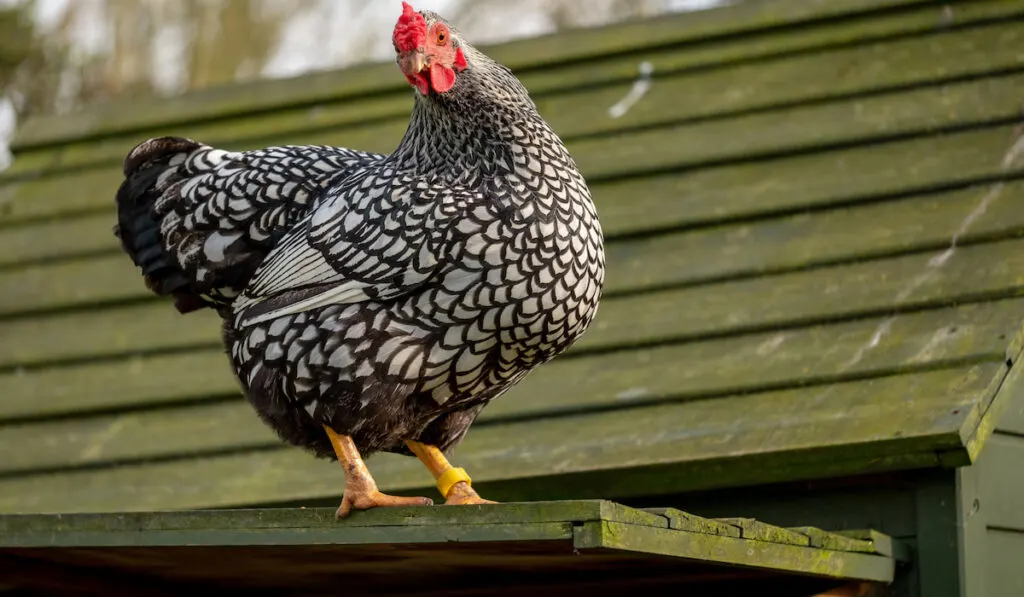
Table of Contents
Origin and History
The Wyandotte chicken has its origin in New York and Ontario, Canada. The breed was named after the Indigenous American tribe residing in New York and Canada, where the breed emerged.
Breeders crossed the Dark Brahma and Spangled Hamburgs in the late 19th century to produce the Wyandotte. After its production, the natives named the new breed Sebrights.
In 1883, the American Poultry Association(APA) admitted the breed into its standard of perfection and named it Wyandotte.
Silver Lace was the first variety to emerge. The other varieties emerged later from continued breeding as the natives tried to improve their features.
Toward the end of the 20th century, the Wyandotte’s population reduced drastically. But thanks to the Livestock Conservancy’s efforts, it was taken off the endangered list in 2016.
Wyandotte Standard Appearance
The APA admitted the Wyandotte chicken breed to its standard of perfection in 1883.
The Silver Lace variety was the first to be admitted, while others followed later.
The following characteristics define the Wyandotte standard appearance.
Appearance
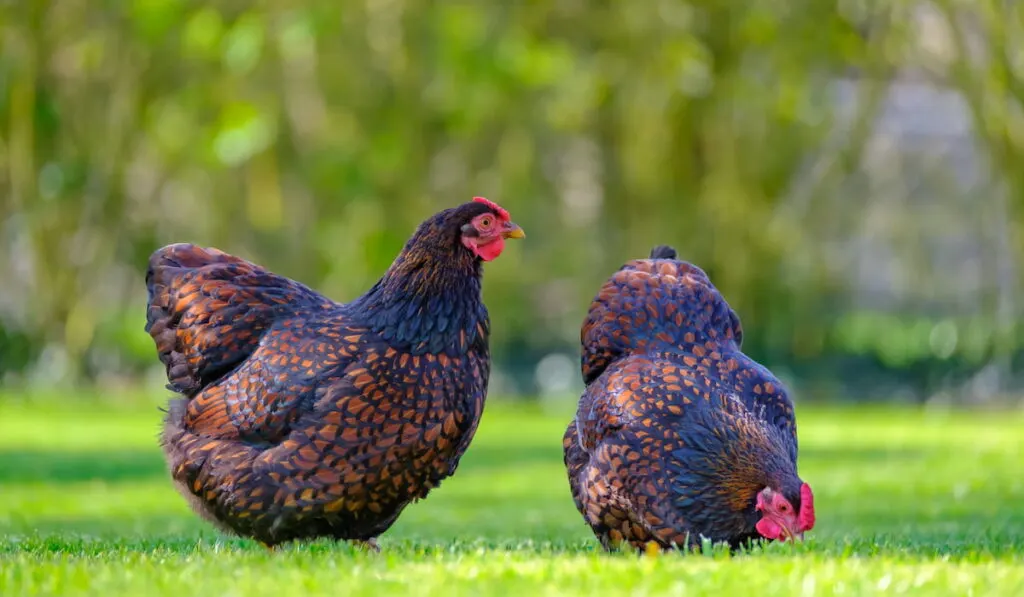
Wyandottes have large bodies and mature fairly quickly. Their rose comb is almost flat with small rounded points.
You can distinguish the males from females through comb size. A male’s comb is larger than a female’s.
The breed has a bright red beak with a hanging wattle. The earlobes are also red with a full neck hackle and a tail tilted at 40°.
The breed is fleshy and muscular with a prominent rounded breast. Its tail is full and wide, with the bottom line of the fluff curving towards the tail.
Wyandotte chickens have dark eyes, yellow skin, and clean legs. Each leg has four toes.
Size
Wyandottes are fairly large with medium height. A mature Wyandotte has a broad back with a well-rounded breast.
A male weighs about 9 pounds when mature, while a female weighs about 6 pounds.
Bantams are available in some varieties and weigh about 3 pounds.
Egg Size and Color
Wyandotte hens lay large eggs that are light brown or cream-colored. Like the many varieties, the eggs shells come in varying shades.
Colors
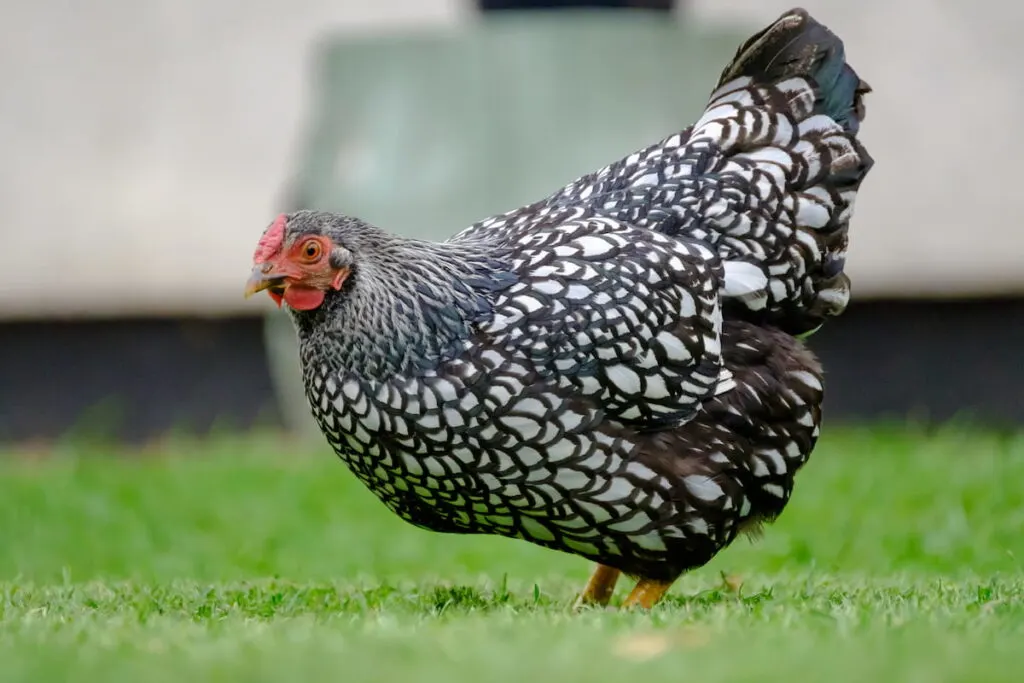
There are about 15 APA-recognized Wyandotte chicken breed colors.
They include
- Red
- Buff
- Blue
- White
- Black
- Barred
- Blue-laced
- Buff-laced
- Silver-laced
- Columbian
- Golden-laced
- Mille fleur
- Partridge
- Silver-penciled
- Buff Columbian
The color varieties do not interfere with Wyandotte breeding. However, some non-APA color varieties emerge from continued breeding.
Although the emerging breeds are not eligible for shows and exhibitions, their attractive nature makes them popular among subsistence backyard farmers.
Temperament
Wyandotte Chickens are calm and friendly to handle. In addition, they are quiet and hence are a terrific addition as a backyard family pet.
If you dwell in an urban area with neighbors nearby, the Wyandotte is your ideal breed.
The breed’s females are rarely broody but make great mothers. Therefore, you will have an easy time raising chicks if you successfully push the beautiful hens into brooding.
Despite their calm personality, this breed tends to dominate when put in a mixed flock.
Given their friendly and calm behavior, these chickens tolerate confinement well.
However, they love foraging, and therefore you should balance their confinement time with run enclosure time.
Lifespan
The Wyandotte breed lives for 6-12 years under good care. Their tolerance to heat and cold is commendable, and they rarely fall sick.
While raising the Wyandotte, allow it enough run time in your yard. The chickens love free-ranging and foraging and enjoy good health when you allow them to roam around.
Uses
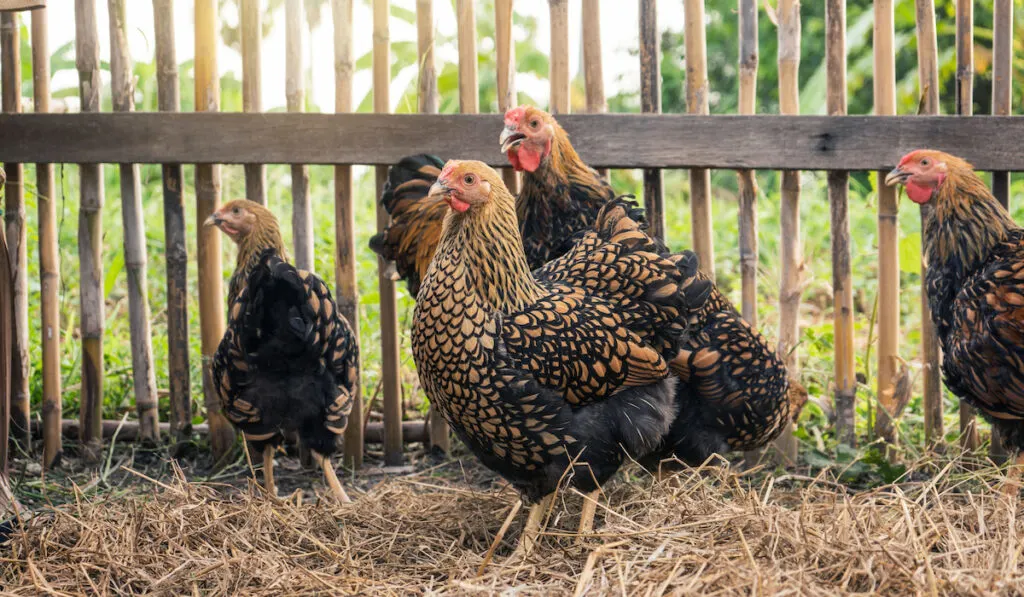
Being a dual-purpose fowl, the Wyandotte produces desirable meat and egg quantities.
The hens start laying eggs when they are 4-5 months old. A Wyandotte hen lays 3-4 eggs per week, making the annual production about 150-200.
Wyandotte hens are more productive in winter than other breeds thanks to their winter tolerance.
Their meat production is also great. A mature rooster weighs 8-9 pounds, while hens weigh 6-7 pounds.
The breed’s flavorful, yellow-skinned white meat is popular among chicken meat lovers.
Meat and egg production aren’t the only Wyandotte chicken uses, however. Poultry farmers show this attractive bird at exhibitions where they showcase its beauty. This enables them to learn more about the variety and connect with other farmers.
They also meet customers for their fowls at the shows. The bird’s beauty makes it ornamental and attracts attention.
The following table summarizes the Wyandotte chicken breed characteristics.
| Characteristics | Details |
| Egg size | Large |
| Average annual egg production | 150-200 |
| Egg color | Brown |
| Temperament | Calm, friendly, and easy to handle |
| Color varieties | Black, gold-laced, silver, buff, Colombian, partridge, and more. |
| Breed size | Large |
| Cold tolerance | Good |
| Heat tolerance | Good |
| Beginner friendly | Yes |
| Family-friendly for your backyard | Yes |
| Uses | Dual purpose |
| Rarity | Common |
| Origin | New York, Canada |
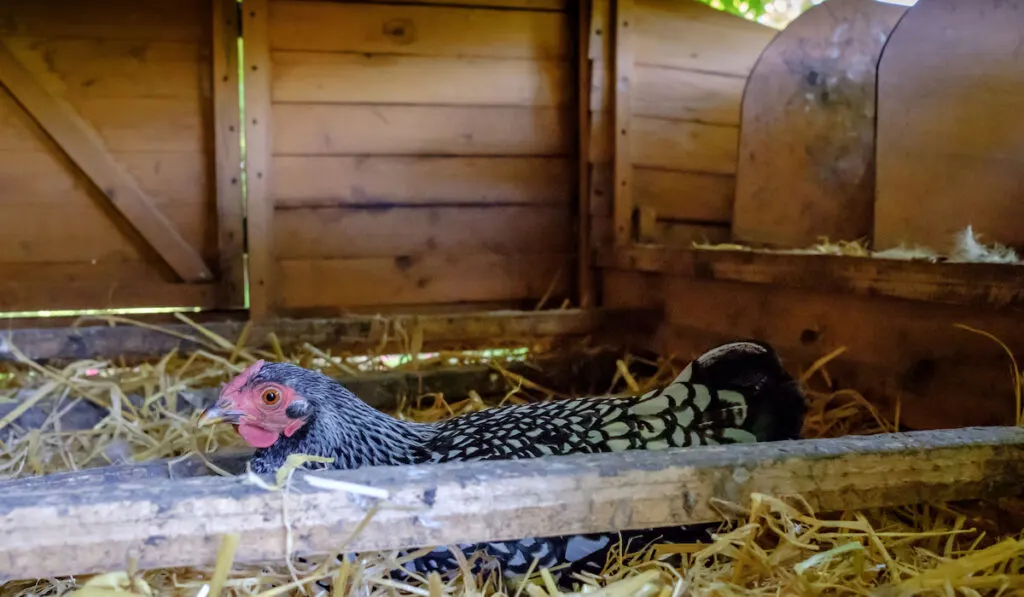
Hatching and Raising
Raising Wyandotte chickens is hardly demanding. The breed loves self-care and tends to fend for themselves.
Hatching, however, can be challenging. The females are not naturally broody and may take a long time before showing any signs of brooding.
This leaves you the extra task of coercing the hens to their nest after continuous egg laying.
Simple practices like providing a dark safe place to sit on the eggs can do the trick. For example, you can hang a dark curtain in front of the nesting area and have the mother sitting on the eggs in no time.
If raising the breed for commercial purposes, consider using an incubator.
The hatching period for Wyandotte eggs is 21-22 days.
Feeding
Chicks require protein for body development and healthy growth. Therefore, ensure you feed them 20% protein feed.
When the chickens are 16-20 weeks old, the females start laying. To enhance their egg production, add 16%-layer feed to their diet.
They also need calcium and vitamins. Calcium helps in shell formation, and vitamin supplements improve their immunity.
Oyster shell is rich in calcium; therefore, include it in your layers’ feed in a separate container.
Like other poultry breeds, Wyandotte chickens require clean water and grit. You should ensure the water containers are clean to avoid contamination.
You can acquire soluble grit for chicks, as mature chickens use the insoluble one.
Housing
Wyandottes are large birds that require a lot of space. Four square feet of coop space is enough for one bird if you only rear this breed.
In a mixed block where the breed interacts with more assertive and flighty varieties, increase the space to six square feet per chicken.
The birds also need 8-10 inches of roosting space.
When constructing perches, use sanded wood and ensure they are stable. The birds like cuddling during winter to keep warm, and their cumulative weight can break weak perches easily.
Since the hens are large, they require at least a square foot of nesting space. Here, they can fit well with no space for double bunking.
The Wyandottes also love roaming. Fencing their run area can help protect them against predators.
A three-foot-high fence is ideal since the birds are heavy and less flighty. The ideal amount of space for each bird in the run area is eight square feet.
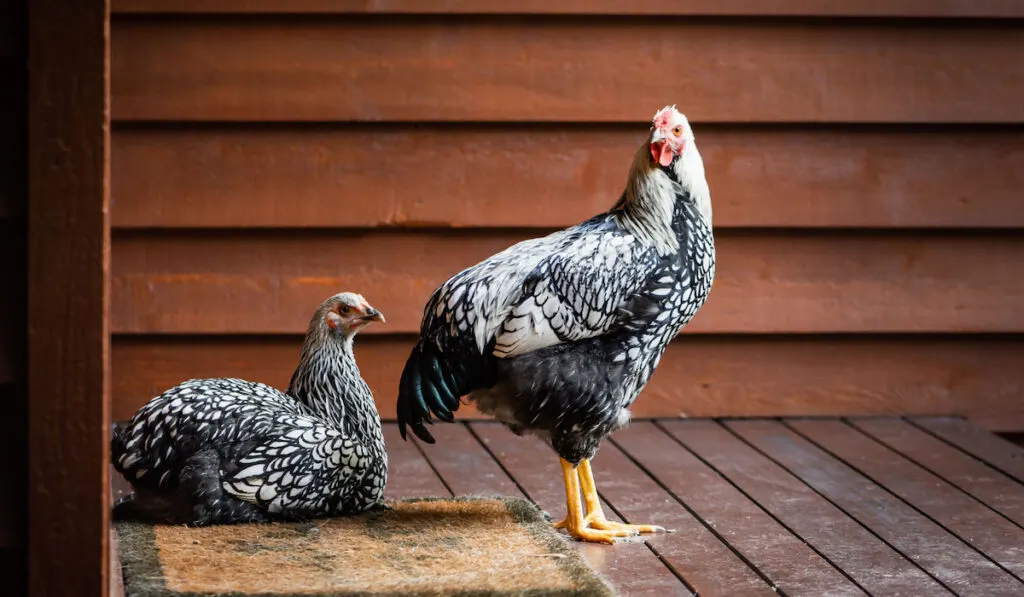
Health Issues
The Wyandotte is a healthy breed and rarely suffers from diseases. They do well in cold areas, and their heat tolerance is average.
You should keep their housing clean to prevent lice and mite attacks.
Cold Tolerance
Wyandotte chickens have excellent cold tolerance. They were bred to withstand the cold winters in North America.
Their dense plumage and rose comb help them shake off cold easily.
Heat Tolerance
The Wyandotte breed survives well in summer, but its heat tolerance is low. This results from their heavy bodies and thick feathering.
To enhance their comfort, provide shades in their free-ranging area. When confined, you should keep the coops well-ventilated.
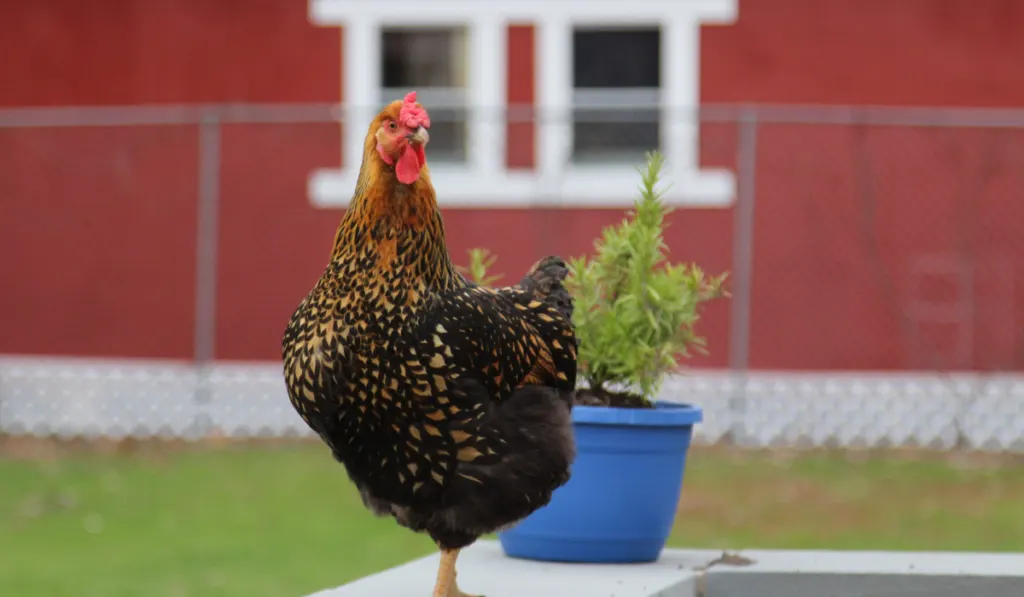
Where to Buy Wyandottes and Prices
The Wyandotte is a common breed and therefore getting them is easy. Many farms and hatcheries have different color varieties to choose from.
You can also search online for e-commerce stores that sell Wyandotte chickens.
Pricing depends on the following:
- Sex. Females cost more than males
- Quantity. The cost per chicken when you buy large quantities is lower.
- Shipping. You may incur additional costs for transportation.
Here is a table showing sample pricing in one poultry farm.
| Sex | Cost per bird |
| Straight run | $4.06 |
| Male | $3.12 |
| Female | $4.80 |
Final Thoughts
The Wyandotte chicken breed is ideal for seasoned farmers and beginners.
Whether you want to venture into chicken farming for the first time, you want to increase your egg and white meat production, or you want to keep it for its beauty, this breed is worth a try.
We all have varying preferences, but the Wyandotte is a breed you can adopt in almost any setup.
Resources
- https://backyardpoultry.iamcountryside.com/chickens-101/wyandotte-chicken-breed-spotlight/
- https://www.chickensandmore.com/wyandotte-chicken/
- https://livestockconservancy.org/about-us/conservation-successes/wyandotte-chicken/
- https://www.mypetchicken.com/blogs/our-blog/wyandotte-chicken-breed-the-ultimate-guide
- https://www.backyardchickencoops.com.au/blogs/learning-centre/wyandottes-a-comprehensive-guide
- https://www.chickensandmore.com/wyandotte-chicken/#Feeding
- https://www.myerspoultry.com/product-sliver-laced-wyandotte
